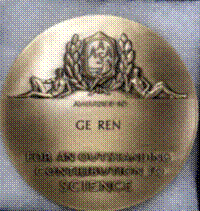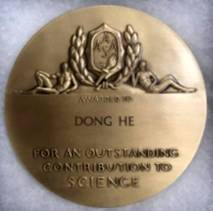IOE's Scientists Win the Newcomb Cleveland Prize
The research team of the Micius quantum satellite, led by Professor PAN Jianwei at the University of Science and Technology of China (USTC), was awarded the 2018 Newcomb Cleveland Prize by the American Association for the Advancement of Science (AAAS). The quantum communication telescope research team from IOE participated in this program, REN Ge and HE Dong received the honor as team representatives.


The medals (Images come from Dangban)
The quantum communication telescope research team developed 4 large aperture ground station telescope systems, improved the high dynamic range high precision telescope tracking control, wide spectrum high efficiency transmission, quantum entanglement and other key techniques, making a great contribution to the success of the scientific experiment of star-ground quantum communication.
In 2017, the research team led by Professor PAN Jianwei and his colleague Professor PENG Chengzhi from the USTC, in collaboration with Professor WANG Jianyu’s team from the Shanghai Institute of Technical Physics of the Chinese Academy of Sciences, Shanghai Engineering Center for Microsatellites, Institute of Optics and Electronics of Chinese Academy of Sciences, Purple Mountain Observatory, Xinjiang Astronomical Observatory and Yunnan Observatories, demonstrated satellite-based distribution of entangled photon pairs to two locations separated over 1200 kilometers on earth and observed a violation of Bell inequality under strict Einstein locality conditions, illustrating the possibility of a future global quantum communication network. A paper on the research titled Satellite-based entanglement distribution over 1200 kilometerswas published on the cover of the Jun. 16th, 2017 issue of Science. On Aug. 10th in the same year, other two research breakthroughs based on the Micius quantum satellite were also reported as cover papers in the journal Nature, titling Satellite-to-ground quantum key distributionand Ground-to-satellite quantum teleportation, respectively. At this point, the ‘Micius’ quantum satellite has successfully accomplished its three established scientific goals, providing reliable technical support for the future development of quantum communication technology.
As the Association's oldest award, the AAAS Newcomb Cleveland Prize was established in 1923. The prize is awarded to the author or authors of an outstanding paper published in the Research Articles or Reports sections of Science. Each annual contest starts with the first issue of June and ends with the last issue of the following May. In the past 20 years, many influential research works in the field of quantum physics were admitted into the list of prize winners, including observation of Bose-Einstein condensation (1995), observation of the Spin Hall effect in semiconductors (2005) and signatures of Majorana Fermions (2012).
